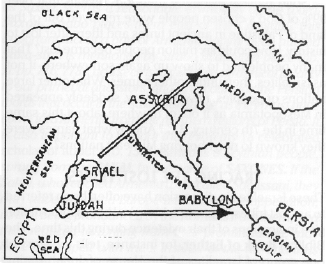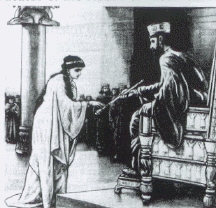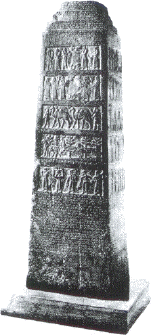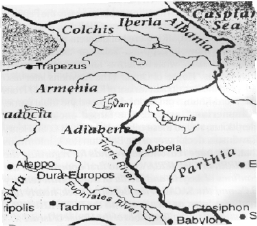THE REAL DIASPORA – (THE MYSTERY OF THE MISSING BIBLE TRIBES!)
A CRYPTIC INTRODUCTION IS GIVEN BY THE APOSTLE JAMES IN HIS EPISTLE, WHICH BEGINS WITH THE WORDS, “JAMES, A SERVANT OF GOD AND OF THE LORD JESUS CHRIST, TO THE TWELVE TRIBES WHICH ARE SCATTERED ABROAD, GREETING.” Who were these ‘twelve tribes’ scattered abroad? Biblical commentaries often plead ignorance as to whom these mysterious people were. For example, the new “Serendipity Bible For Study Groups” (Zondervan, Inc.) makes this statement: “lt is not clear to whom James is writing.”
Adding to the mystery, we find that a similar expression was also used by the Apostle Peter in the introduction to his own First Epistle: “Peter, an apostle of Jesus Christ, to the strangers (margin, ‘sojourners of the dispersion’) scattered throughout Pontus, Galatia, Capadocia, Asia, and Bithynia…” Thus, both James and Peter address their epistles to these mysterious “strangers” who were “scattered abroad” from Palestine. Were these just a handful of Jewish traders who had settled along trade routes, as some commentators suggest? Why then would a few lone individuals be referred to as “the twelve tribes?”
THE JEWISH DIASPORA
The word, “diaspora” (from the Greek, meaning scattered or dispersed) has often been used by historians to describe the migration of Palestinian Jews, which occurred after the destruction of Jerusalem in AD. 70. The Roman general, Titus, and his army invaded Palestine, laying siege to all of the cities and towns there. After Jerusalem was overrun, the Jewish fortress at Masada held out an additional four more years, until it, too, fell in AD. 74. An estimated 1,100,000 Jews died in that conquest according to the early historian, Flavius Josephus. Thousands of additional Jews either fled from Palestine, or were carried away as slaves. This Jewish “exodus” or “diaspora,” however, occurred about ten to twenty-five years after the Epistles of James and Peter were written. Many scholars give a date of about A.D. 45 for James’ epistle, and Peter’s first epistle was written most probably prior to A.D. 64 when Nero began his persecution. Therefore, based on these dates, it is clear that the Jewish diaspora of A.D. 70 is not the “scattering abroad” to which both James and Peter refer. Of what scattering, then, do they relate?
ANCIENT DISPERSIONS OF ISRAEL
Centuries before, upon the death of Solomon about 926 B.C., God’s chosen nation had become divided into two kingdoms: the northern ten-tribe kingdom of the house of Israel, and the southern two-tribe kingdom of Judah. (1 Kings 12) Then, in four invasions between 762 and 676 B.C., the Assyrians conquered and deported the ten tribes and most of the cities of the southern kingdom. (Jerusalem itself was spared due to the prayers and repentance of King Hezekiah, as related in II Kings chapter 19.) These captive Israelites were transported hundreds of miles away northeast to the land of Media on the shores of the Caspian Sea, in northern Mesopotamia. They never returned, becoming lost to history, as the International Standard Bible Encyclopedia relates, “The northern ten tribes had been taken into captivity by the Assyrians and have become known as the lost tribes of Israel. The sole surviving identifiable tribe was Judah, and when this was conquered [a century later In 587 B.C.] by Nebuchadnezzar, the captives became known as Jews – a word that developed from ‘Judeans.’ The returning exiles were henceforth known as Jews, and the name Judah was loosely used to refer to the region they occupied. ” Thus the word “Jew” was derived from the name of the tribe and kingdom of Judah, which suffered in the seventy year Babylonian captivity. But historians relate that the Ten-tribe House of Israel did not return to Palestine from their earlier Assyrian dispersion, but became lost to history.
These lost tribes are referred to in the apocryphal Second Book of Maccabees, written between 50-100 B.C., long before the New Testament fall of Jerusalem and modern Jewish “diaspora.” In chapter one, verse 27, we read, “Gather together our scattered people… ” The word ‘scattered’ is rendered in the Septuagint version by the Greek word, “diaspora.” In the New Testament, John 7:35 also recognizes Israel as being “dispersed,” (again from the Greek word, diaspora) long before the Roman conquest of A.D. 70. Thus the dispersion of the Lost Ten Tribes of Israel is the real diaspora spoken of in both the Old and New Scriptures.
THE NUMBER OF THOSE DISPERSED
How many Israelites went into dispersion? McClintock & Strong’s Encyclopedia gives us the number of Israelites at the time of the captivity: “With regard to population…. in I Chronicles 21:5-6, the numbers (of fighting men) are stated at 1,100,000 (Israel) and 470,000 (Judah) respectively, with the intimation that Levi and Benjamin were not included.. According to the general laws observable in such cases, these numbers may be said to represent an aggregate population of from five and a half to six millions … it may be safely reckoned that the population subject to each king was about four times the number of the fighting men in his dominions.’
Six million Israelites went out of the land of Palestine into captivity! Out of this large number, how many ever returned? The Bible itself provides us an answer to that question. In the book of Ezra 2.1. 64, 65.We read, “Now these are the children of the province who went up out Of the captivity.. The whole congregation together was forty and two thousand, three hundred and threescore. Besides their servants and their maids, of whom there were seven thousand three hundred thirty and seven; and there were among them two hundred singing men and singing women.” The returning captives constituted a combined total of only 49,897 persons, or less than eight tenths of one percent of those dispersed! The remainder, nearly six million in 762 BC, are still lost to recorded history.
Solid Biblical evidence therefore reveals that over 99% of God’s chosen people were removed out of the land of Palestine in ancient times and thereafter lost to history. How could six million people become lost? That many people had to show up again somewhere, if not as Israelites, then under other names. What other large nations or peoples, new to history, suddenly appeared in Mesopotamia as if out of nowhere, about this same time in the 7th century, B.C.? And by what names were they known to neighbouring Mid-east nations?
TRACING THE LOST TRIBES
These Israelites in dispersion have often been referred to as “lost tribes,” but some historical bits of information give indications of their existence during this time. The Biblical Book of Esther for instance, tells the story of one group of Israelites of- the House of Judah during their captivity in the city of Susa about 300 miles east of the city of Babylon.
(The king of Persia and Esther are depicted here.)
This was 480 B.C., a full century after the fall of Jerusalem (Esther 2:6)
The Apocryphal book of Tobias, or Tobit, took place even earlier, ‘When he was made captive In the days of Salmanasar king of the Assyrians. ” (1:2) This faithful man of the tribe of Naphtali lived in the city of Nineveh in the seventh century, B.C., becoming a captive in 721 B.C. in the third Assyrian conquest of the House of Israel. The Book of Tobit closes with a prediction that “the destruction of Nineveh is at hand,” (14:6), which occurred in 612 B.C.
Another sighting of these lost tribes occurred about 500 miles northwest of Susa in the region of Behistun (or Bisutun), where today may be seen a giant rock carving high up a 1,700 foot sheer mountain face. (See the monument below)
 Deciphered in 1835 by famed archaeologist, Sir Henry Rawlinson, it was commissioned by the ancient Persian King, Darius Hystaspes, surnamed The Great. The reproduction illustrated, shows the Behistun Rock carvings, in which Darius recounts his battles with the Saka or Scythians. King Darius places his left foot on the body of one rebel leader, while nine other rebel princes are led to him with hands bound and a rope around their necks. The text is repeated in three languages, Persian, Susian (the language of the city of Susa where Queen Esther lived), and Babylonian. By comparing the Persian and Babylonian versions of the text, we know that these tribes were known to the Persians as Saka, and to the Babylonians as Gimirri. The Behistun inscription has been dated to about 516 B.C., over two centuries after the northern kingdom of the House of Israel was dispersed by Assyria. Scythian, a Greek form of the name Saka, came to mean a wanderer or tent-dweller, and well described the Israelites in dispersion far from their cities and homes in Palestine.
Deciphered in 1835 by famed archaeologist, Sir Henry Rawlinson, it was commissioned by the ancient Persian King, Darius Hystaspes, surnamed The Great. The reproduction illustrated, shows the Behistun Rock carvings, in which Darius recounts his battles with the Saka or Scythians. King Darius places his left foot on the body of one rebel leader, while nine other rebel princes are led to him with hands bound and a rope around their necks. The text is repeated in three languages, Persian, Susian (the language of the city of Susa where Queen Esther lived), and Babylonian. By comparing the Persian and Babylonian versions of the text, we know that these tribes were known to the Persians as Saka, and to the Babylonians as Gimirri. The Behistun inscription has been dated to about 516 B.C., over two centuries after the northern kingdom of the House of Israel was dispersed by Assyria. Scythian, a Greek form of the name Saka, came to mean a wanderer or tent-dweller, and well described the Israelites in dispersion far from their cities and homes in Palestine.
Israel was known by different narnes to different neighbouring peoples. One of the most popular archaeology texts found in public libraries is “The March of Archaeology,” by C.M. Ceram. He points out that the Assyrians referred to the Israelites by the narne of KHUMRI. Ceram says, “One of [Sir Austen Henry] Layard’s most interesting finds … is undoubtedly the “Black Obelisk” of Assyrian king Salmanasar III (859-824 8. C.) This obelisk, about six and one half feet high and covered on all four faces with script and reliefs … gives us vignettes of the clothing and customs of the peoples whom Salmanassar boasts of conquering.
In the second row of carvings, Kinsmen of Jehu, son of a man named KHUMRI, are shown bringing tribute consisting of metal and vessels of silver and gold.. KHUMRI was the Assyrian designation of the Jews… This monument of the Assyrian king has pictures of conquered princes paying tribute, including “Jehu, the son of Khumri,” a term designating him as an Israelite. This Assyrian name for Israel, Khumri, translates as “House of Omri,” after an Israelite king who gained fame for a new law-code he developed (Micah 6:16). Famed early 20th century historian archaeologist, Archibald Henry Sayce, in his book, Higher Critics and the Monuments, p. 396, adds: ‘lt was, however, in the lime of Ahab the son of Omri that the Assyrians first became acquainted with the northern kingdom of lsrael, and consequently Samaria continued ever afterwards to be known to them as Beth-Omri, the ‘house of Omri’. ”
KHUMRI
Scholars confirm that the people known to the Persians as SAKA, to the Babylonians as GIMIRRI, and to the Assyrians as KHUMRI, were but different names for the Lost Ten Tribes in captivity. “Saka” or “Sacae” meant “House of Isaac,” while the terms “Khumri” and “Gimirri” translate as “House of Omri.” (The Assyrians later also adopted the Babylonian variant of Khumri, Gimirr.) From this word Khumri or Gimirri developed the tribal name, “Cimmerian,” as well. The famed ancient writer, Herodotus, visited these tribes about 450 B.C. Sir Henry Rawlinson, decipherer of the Behistun Rock, informs us that, “We have reasonable grounds for regarding the GIMIRRI, or CIMMERIANS, who first appeared on the confines of Assyria and Media in the seventh century B.C., and the SACAE of the Behistun Rock, nearly two centuries later, as identical with the BETH-KHUMREE of Samaria, or the Ten Tribes of the House of lsrael… “‘ George Rawlinson, translator of the History Of Herodotus, stated, “The SACAE or Scythians, who were termed GIMIRRI by their Semitic neighbours, first appear in the cuneiform inscriptions as a substantive people under Esar-Haddon in about B.C. 684.” By this date the Ten Tribes, Israel-Gimirri, were entirely resident in Assyria, for a great deportation of the whole seed of Ephraim (Jeremiah 7:15) had removed them from Palestine. We read . ….. “there was none left but the tribe of Judah only … so was Israel carried away out of their own land to Assyria unto this day.” (2 Kings 17:18,23).
ISRAEL = SAKA = GIMIRRI = KHUMRI
The famed Roman-Jewish historian, Flavius Josephus, said in the first century, A.D., “Therefore there are but two [Israel] tribes In Europe and Asia subject to the Romans, while the ten tribes are beyond the Euphrates till now, and are an immense multitude, and not to be estimated by numbers.” The “lost” ten tribes were dwelling beyond the Euphrates Valley, travelling northward, so our next step is to trace their migrations through the Caucasus.
BIRTH OF THE CAUCASIAN TRIBES
The Jewish Encyclopedia says: “If the Ten Tribes have disappeared, the literal fulfiliment of the prophecies would be impossible; if they have not disappeared, obviously they must exist under a different name.” This is the only real choice! If the Bible’s prophecies are to be literally fulfilled, the Lost Tribes must be known today by a name other than “Israel”. But what other name?
“... the Sacae, or Scythians, who, again, were the Lost Ten Tribes”
The Jewish Encyclopedia vol. 12, p.250
Historian Sharon Turner, author of the scholarly three-volume History of the Anglo-Saxons, tells us this: “... Of the various Scythian nations which have been recorded, the SAKAI, or SACAE, are the people from whom the descent of the SAXONS may be inferred with the least violation of probability. Sakai-suna, or the sons of the Sakai, abbreviated into Saksun, which is the same sound as Saxon, seems a reasonable etymology of the word, Saxon. Strabo places them east of the Caspian… this important fact of a part of Armenia having been named Saka-sina is mentioned by Strabo in another place (lib. xi pp. 776, 778); and seems to give a geographical locality to our primeval ancestors, and to account for the Persian words that occur in the Saxon language as they must have come into Armenia from the northern regions of Persia. It is also important to remark that Ptolemy [a celebrated scholar of about A.D. 150] mentions a Scythian people, sprung from the SAKAI, by the name of SAXONES. If the Sakai, who reached Armenia were called Sacassani, they may have traversed Europe with the same appellation; which, being pronounced by the Romans from them, and then reduced to writing from their pronunciation, may have been spelled with the x instead of the ks, and thus Saxones would not be a greater variation from Sacassani or Saxsuna, than we find between French, Francois, Franci, and their Greek name Phrange; or between Spain, Espagne, and Hispania.”
“THE IDENTIFICATION OF THE SACAE, OR SCYTHIANS, WITH THE TEN TRIBES BECAUSE THEY APPEAR IN HISTORY AT THE SAME TIME, AND VERY NEARLY IN THE SAME PLACE, AS THE ISRAELITES REMOVED BY SHALMANESER, IS ONE OF THE CHIEF SUPPORTS OF THE THEORY WHICH IDENTIFIES THE ENGLISH PEOPLE, AND INDEED THE WHOLE TEUTONIC RACE, WITH THE TEN TRIBES.”
Proofs abound as to the whereabouts of these “missing tribes.” In the apocryphal book of First Maccabees 12:21 is a statement (of about 100 B.C.) that “It has been found In writing concerning the Spartans [Greeks] and the Jews that they are brethren, and that they are of the stock of Abraham ” Similar connections abound between ancient Israel and Italy, Spain, Ireland, Britain, and other countries in Europe.
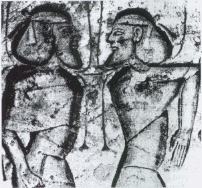 If this is true, then should the Anglo-Saxons have “Jewish features?” On this, the Westminster Historical Atlas To The Bible reproduces an ancient inscription from the Temple of Rameses III at Medinet Habu in Egypt, and states, Canaanite captives in Egypt being led before the Pharaoh. This relief, which portrays the general appearance of lsraelites as well as Canaanites, is a good representation of the typical Semite of the day. Note the noble, aristocratic features, particularly the finely set noses, and the long hair and beards. It is commonly thought that Israelites had “hooked noses, ” but this was originally a Hittite or Armenoid feature. “
If this is true, then should the Anglo-Saxons have “Jewish features?” On this, the Westminster Historical Atlas To The Bible reproduces an ancient inscription from the Temple of Rameses III at Medinet Habu in Egypt, and states, Canaanite captives in Egypt being led before the Pharaoh. This relief, which portrays the general appearance of lsraelites as well as Canaanites, is a good representation of the typical Semite of the day. Note the noble, aristocratic features, particularly the finely set noses, and the long hair and beards. It is commonly thought that Israelites had “hooked noses, ” but this was originally a Hittite or Armenoid feature. “
WORD ORIGINS
(House of) OMRI -> KHUMRI (Assyrian)–> CIMMERIAN ~ (Greek) – > KYMRY -> CELT
GIMIRRI (Babylonian)
(House of) ISAAC -> SAKA (Persian)
SACA-SUNA, or “Sons of the Saka ” – > SAXONS
FROM MIDDLE-EAST TO EUROPE
The origin of the Caucasian Race is shrouded in antiquity, but this much is certain: The name itself indicates that many of these people streamed into Europe through the Caucasus Mountain region of Eastern Europe, just north of Assyria and Palestine. Historians still debate whether these tribes originated in northern Europe and later travelled south to the Caucasus region, or conversely, originated down in Mesopotamia and migrated north through the Caucasus into Europe. The Encyclopedia Britannica, while professing no final opinion on this, makes the revealing admission, “It has been observed with truth that so many populous nations can hardly have sprung from the Scandinavian peninsula.” The same source also points out that these tribes spoke a language akin to ancient “Iranian” (i.e., an early Mesopotamian dialect. This was no accident, for the Israelites descended from Abraham who originated in Chaldea in Mesopotamia.) It would therefore seem obvious that these newly discovered peoples originated in Mesopotamia, at the same time and place that the Ten Tribes of Israel were “lost” and disappeared from history. God’s people disappeared under the name of Israel by the early 7th century B.C., and immediately reappeared in the same region under other names by which they played an important part in the early history of Asia Minor and Eastern Europe.
Many history books show an area marked, “Iberia,” or HEBREW’S LAND, in the Caucasus Mountain region between the Caspian and Black Seas, north of the Euphrates River. (See the upper portion of the following map.) The word, Hebrew, means a descendant of Eber, the great-grandson of Noah. Even to this day, Spain is known as the Iberian Peninsula, and Ireland by the slight variation, Hibernia, both indicating their Hebrew origins in antiquity.
In the apocryphal book of 2 Esdras 13, verse 40 we read: “These are the Ten Tribes, which were carried away prisoners out of their own land in the time of Osea the king, whom Salmanesar, the king of Assyria, led away captive, and he led them over the waters, and so come they into another land. But they took this counsel among themselves, that they would leave the multitude of the heathen, and go forth into a further country, where never mankind dwelt… And they entered into Euphrates by the narrow passages of the river… For through that country there was a great way to go, namely of a year and a half; and the same region is called Arsareth. ” “Ar” is the Chaldean word for river, and Biblical archaeologist, Dr. E. Raymond Capt believes that this may refer to Eastern Europe, in the region of modern Rumania, where a River Sareth exists to this day.
FULFILLED PROPHECY
The New Testament verifies that not only would Israel continue to exist as a people, but they would be restored spiritually through belief in their Saviour, the Son of God. The Apostle Paul, quoting the prophet Hosea says, “Yet the number of the children of Israel shall he like the sand of the sea, which cannot be measured nor numbered; and it shall come to pass that, in the place where it was said unto them, Ye are not my people, there it shall be said unto them, Ye are the sons of the living God. “ (Hosea 1:10; Romans 9:26) Where has this prophecy seen fulfillment? Who are these millions who are called numerous as the sand of the sea, are popularly told are “not God’s people Israel, ” and yet are known as “Sons of the living God,” or Christians? That this is the proper interpretation of the prophecy may be seen in the evangelical publication, Pulpit Commentary ,which maintains, “The place, then, where they should be called the sons of the living God is wheresoever they should believe in Christ. ” (vol 18, p. 270) Yes, Hosea’s prophecy has been fulfilled today in the nations of Christendom, “Christ’s Kingdom,” where we are told that we are not God’s people, Israel, but that we are “the sons of the living God,” or Christians. It is therefore no coincidence that 95% of Bibles, gospel tracts, and missionary work go out from “Caucasian” Christian lands! We are the modern descendants of God’s servant people, fulfilling prophecy even as “blindness in part has happened to Israel ” (Romans 11:25).
The prophet Isaiah stated, “And the nations shall see thy righteousness, and all kings thy glory; and thou shalt be called by a new name, which the mouth of the Lord shall name. ” (Isaiah 62:2) What new name was prophesied for Israel? Hosea said it was “Sons of the Living God,” or Christians!
Historians record the arrival of millions of dispersed tribes, known to us today as Cimmerians, Angles, Saxons, Scythians, and similar names, who flooded into Europe from Asia Minor in the early pre-Christlan centuries. They poured through the Caucasus Mountain region (whence the name, “Caucasian”) into southeastern Europe at the very same time and place as six million lost Israelites disappeared from history. Surely the disciples of Christ also knew this fact, for they not only went straight to Europe to spread the gospel, but James and Peter addressed their epistles to this same people, “the twelve tribes scattered abroad” to Europe. These are the prophesied Israel “company of nations” (Genesis 35:11), now “thousands of millions” strong, whose colonizing descendants long ago began to “possess the gate of those which hate them.” (Genesis 24:60) The prophetic marks are certain: the lost and scattered tribes of the diaspora have been found!
An effort has been made by some to allegorize the twelve tribes to whom Peter and James wrote their epistles, as if the reference corporately referred to all Christians. But to the contrary, the Pulpit Commentary explains, ‘It appears to have been written, mainly at least, to Israelites of the dispersion. ” (vol. 18, p. 269)
In 1723, the French church scholar and Huguenot refugee, Dr. Jacques Abbadie, wrote a book titled, “The Triumph of Providence” in which he stated, “Unless the ten tribes of Israel are flown into the air, or sunk into the earth, they must be those ten Gothic tribes that entered Europe in the fifth century, B.C…. and founded the ten nations of modern Europe.”
CIMMERII “An ancient people … one body of whom is called in Assyrian sources Gimirrai and is represented as coming through the Caucasus. They were probably Iranian speakers … Later writers identified them with the Cimbri of Jutland, who were probably Teutonized Celts”
Encyclopedia Britannica, 14th ed. 1957, 5:70
The Apostle Paul, in his letter to the Galatians on the border of Europe stated, “They which are of faith, the same are the children of Abraham. “ (Galatians 3:7) Yes, the nations of Christendom ARE the descendants of Abraham and the Israelites of the Bible! As Peter said to these “sojourners of the dispersion,” so we say to you, ” Wherefore the rather, brethren, give diligence to make your calling and election sure; for if ye do these things, ye shall never fall. “ (II Peter 1:10)
One of our goals in preparing this tract was to prove our case using documentary evidence from secular and independent sources, rather than our own opinions. Yet, space limitations allowed us to present only a small portion of all the evidence concerning the Lost Tribes.
REFERENCES:
1 The Serendipity Bible For Study Groups, Zondervan Inc., p. 1578
2 The Jewish War, Flavius Josephus, book vi, chapter ix, par. 420
3 McClintock & Strong’s Bible Encyclopedia, 198 1, vol. 11, p. A 08
4 International Standard Bible Encyclopedia; Bromiley, 1982, vol. 2, pp. 1149-1150
5 McClintock & Strong’s Bible Encyclopedia, 1981, vol. iv, pp. 695,1052
6 Encyclopedia Britannica, 14th ed., 1957, vol. 17, p. 550, article, ‘Persia’
7 The March of Archaeology, by C.W Ceram, 1958, page 216
8 The Origin Of The Nations, by Sir Henry Rawlinson
9 History of Herodotus, translated by George Rawlinson, vol. 1, p. 196
10 Antiquities of the Jews, Flavius Josephus, book xi, ch. v, pan 2
11 The Jewish Encyclopedia, 1909, vol. 1 2, p.249, article, ‘Tribes, Lost Ten’
12 History of the Anglo-Saxons, Sharon Turner, 1836, vol. 1, pp. 100-101
13 Westminster Historical Atlas To The Bible, 1945 edition, p. 24
14 Encyclopedia Britannica, 11 th ed., vol. 12, p. 272, article, “Goths”
15 Holman Book of Biblical Charts, Maps, & Reconstructions, 1993, p.132
16 Quoted in National Message Magazine, 611957, p. 188-189

